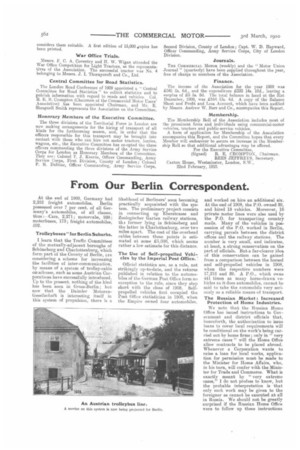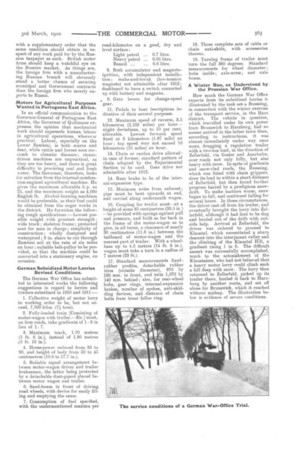From Our Berlin Correspondent.
Page 6

Page 7

If you've noticed an error in this article please click here to report it so we can fix it.
At the end of 1909, Germany had 2,2.52 freight automobiles. Berlin possessed over 7 per cent, of all Germany's automobiles, of all classes, thus :—Cars, 2,271; motorcabs, 938; motorbuses, 173; freight automobiles, 592.
Trolleybuses " for Berlin Suburbs.
I learn that the Traffic Committees of the mutually-adjacent boroughs of Scboneberg and Charlottenburg, which form part of the County of Berlin, tre considering a scheme for increasing the facilities of inter-communication, by means of a system of trolley-cable onnibuses, such as some Austrian Corporations have successfully introduced. Up to the present, nothing of the kind has been seen in Grass-Berlin; but now that the Daimler MotorenGesellschaft is interesting itself in this system of propulsion, there is a
likelihood of Berliners' soon becoming practically acquainted with the system. The preliminary project consists in connecting up Eberstrasse and Zoologischer Garten railway stations, the former lying in Schoneberg and the latter in Charlottenburg, over two miles apart. The cost of the overhead cables between these points is estimated at some £5,000, which seems rather a low estimate for this distance.
The Use of Self-propelled Vehicles by the Imperial Post Office::
Official statistics are, as a rule, not strikingly up-to-date, and the returns published in relation to the automobiles of the German Post Office form no exception to the rule, since they stop short with the close of 1908. Selfpropelled vehicles first occupied the Post Office statistician in 1906, when the Empire owned four automobiles, and worked on hire an additional six. At the end of 1908, the P.O. owned 39, and hired 13 vehicles. Moreover, 16 private motor lines were also used by the P.O. for transporting country mails. Many of the vehicles in possession of the P.O. worked in Berlin, carrying parcels between the district offices and the railway stations. The number is very small, and indicates, at least, a strong conservatism on the part of officials. But a far-clearer idea of this conservatism can be gained from a comparison between the horsed and self-propelled vehicles in 1908, when the respective numbers were 17,216 and 39. A P.O., which owns 441 times as many horse-drawn vehicles as it does automobiles, cannot be said to take the automobile very seriously as a reliable means of transport.
The Russian Market : Increased Protection of Home Industries.
We noto that the Russian Home Office has issued instructions to Government and district officials that, henceforth, the authorization to issue loans to cover local requirements will he conditional on the work's being carried out by home firms; only in " very extreme eases" will the Home Office allow contracts to be placed abroad. Whenever a Corporation wants to raise a loan for local works, application for permission must be made to the Minister for Home Affairs, who, in his turn, will confer with the Minister for Trade and Commerce. What is exactly meant by " very extreme cases," I do not profess to know, but the probable interpretation is that only such work may be given to the foreigner as cannot be executed at all in Russia. We should not be greatly surprised if the Russian Home Office were to follow up these instructions with a supplementary order that the same condition should obtain in respect of any work paid for by the Russion taxpayer as such. British motor firms should keep a watchful eye on the Russian market. As things are, the foreign firm with a manufacturing Russian branch will obviously stand a better chance of securing municipal and Government contracts than the foreign firm who merely exports to Russia.
Motors for Agricultural Purposes Wanted in Portuguese East Africa.
In an official communication to the Governor-General of Portuguese East Africa, the Governor of Quilimane expresses the opinion that mechanical work should supersede human labour in agricultural operations, wherever practical. Labour, especially on the Lower Zambesi, is both scarce and dear, while cattle and horses soon suecumb to climatic diseases; steamdriven machines are unpractical, as they are too heavy, and there is great difficulty in procuring coal and fresh water. The Governor, therefore, looks for salvation from the internal-combustion-engined agricultural machine. He gives the maximum allowable h.p. as :24, and the maximum weight as 4,000 English lb. Alcohol-burning machines would be preferable, as their fuel could be obtained from the sugar works in the district. He furnishes the following rough specifications :-Lowest possible weight with greatest strength • wide track ; skeleton frame ; protected seat for man in charge ; simplicity of construction ; wholly dustproof and waterproof ; 8 in. share to cut through Zambesi soil at the rate of six miles an hour ; suitable belt-pulley to be provided, so that the machine could be .converted into a stationary engine, on occasion.
German Subsidized Motor Lorries Revised Conditions.
The German War Office has submitted to interested works the following .suggestions in regard to lorries and trailers subsidized in 1910 and 1911 : 1. Collective weight of motor lorry in working order to be, but not exceed, 7,500 kilos. (74 tons).
2. Fully-loaded train [Consisting of motor-wagon with trailer.-En.] must, on firm roads, take gradients of 1: 8 in lieu of 1 ; 7.
3. Maximum track, 1.70 metres (5 ft. 6 in.), instead of 1.80 metres ,(5 ft. 10 in.).
4. Horse-power reduced from 35 to '30, and height of body from 50 to 45 centimetres (10.6 to 17.7 in.).
5. Reliable signal arrangement between motor-wagon driver and trailer brakesman, the latter being protected by a detachable dust-guard placed between motor wagon and trailer.
6. Sand-boxes in front of driving road wheels, with device for easily filling and emptying the same.
7. Consumption. of fuel specified, with the undermentioned maxima per road-kilometre on a good, dry and level surface : Light petrol ,.. 0.7 litre. Heavy petrol ... 0.65 litre.
Benzol ... 0.6 litre.
8: Both accumulator and magnetoignition, with independent installntion; make-and-break (low-tension magneto) not admissible after 1912; dashboard to have a switch connected up with battery and magneto.
„ 9. Gate levers for change-speed gear.
11. Pedals to bear inscriptions indicative of their several purposes.
12. Maximum speed of reverse, 3.5 kilometres (2.192 miles) per hourslight deviations, up to 10 per cent. allowable. Lowest forward speed fixed at 3 kilometres (1.87 mile) an hour ; top speed may not exceed 16 kilometres (1.0 miles) an hour.
13. Chain or card= drive allowed: in case of former, standard pattern of chain adopted by the Experimental Section to be used. Gear drive not admissible after 191.2.
14. Rear brake to be of the internal-expansion type.
15. Minimum noise from exhaust; pipe must be bent upwards at end, and carried along underneath wagon.
16. Coupling for trailer must-at a height of some 85 centimetres (33.3 in ) -be provided with springs against pull and pressure, and built so far back in the frame of the motor-wagon as to give, in all turns, a clearance of nearly 30 centimetres (11.8 in.) between the tailboard of motor-wagon and the nearest part of trailer. With a wheelbase up to 4.5 metres (14 ft. 8 in.), wagon must take a turn in a radius of 7 metres (23 ft.).
17. Standard measurements fixed : rubber profiles, detachable rubber tires (outside diameter), 870 by 120 mm. in front, and twin 1,070 by 140 mm. behind; also, for rear-wheel hubs, gear rings, internal-expansion brakes, number of spokes, anti-skidding devices, and distance of chain bolts from inner felloe ring. 18. Three complete sets of cable or chain anti-skids, with accessories thereto.
19. Turning frame of trailer must turn the full 360 degrees. Standard measurements for wheel diameter ; hubs inside ; axle-arms ; and axle boxes.
A Winter Run, as Understood by the Prussian War Office.
How much the German War Office expects from its subsidized lorries is illustrated by the task set a 13uessing, in connection with the winter exercise of the transport service, in the Harz district. The vehicle in question, which travelled under its own power from Brunswick to Harzburg, had no sooner arrived in the latter town than, according to instructions, it was almost immediately under way once more, dragging a regulation trailer with a two-ton load, in the direction of Zellerfeld, via Gooier and Auerhahn, over roads not only hilly, but also heavy with snow. In spite of gradients and snow-clad roads, the Buessing, which was fitted with chain grippers, drew its load to within a short distance of Zellerfeld, but then found further progress barred by a prodigious snowdrift. To make matters worse, snow began to fall, and continued falling for several hours. In these circumstances, the driver cast off from his trailer, and eventually brought the lorry into Zellerfeld, although it had first to be dug and hauled out of the drift with outside help. Arrived at Zellerfeld, the driver was ordered to proceed to Klaustal, which necessitated a sharp descent into the interjacent valley and the climbing of the Klaustal Hill, a gradient rising 1 in 6. The difficult ascent was successfully accomplished, much to the astonishment of the Klaustalers) who had not believed that a heavy motor lorry could climb such a hill deep with snow. The lorry then returned to Zellerfeld, picked up its trailer there, hauled it back to Harzburg by another route, and set off alone for Brunswick, which it reached without mishap. The illustration below is evidence of severe conditions.






















